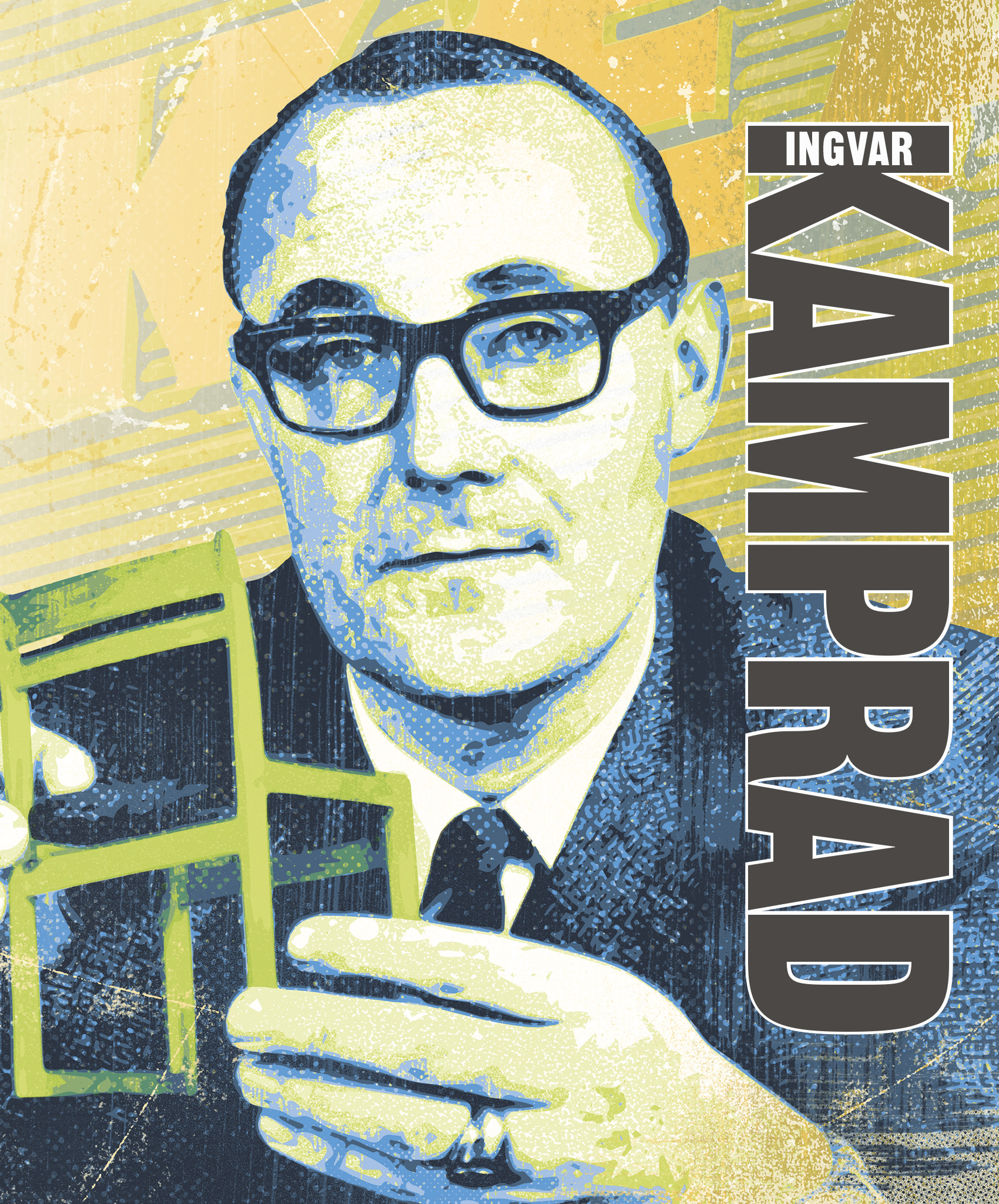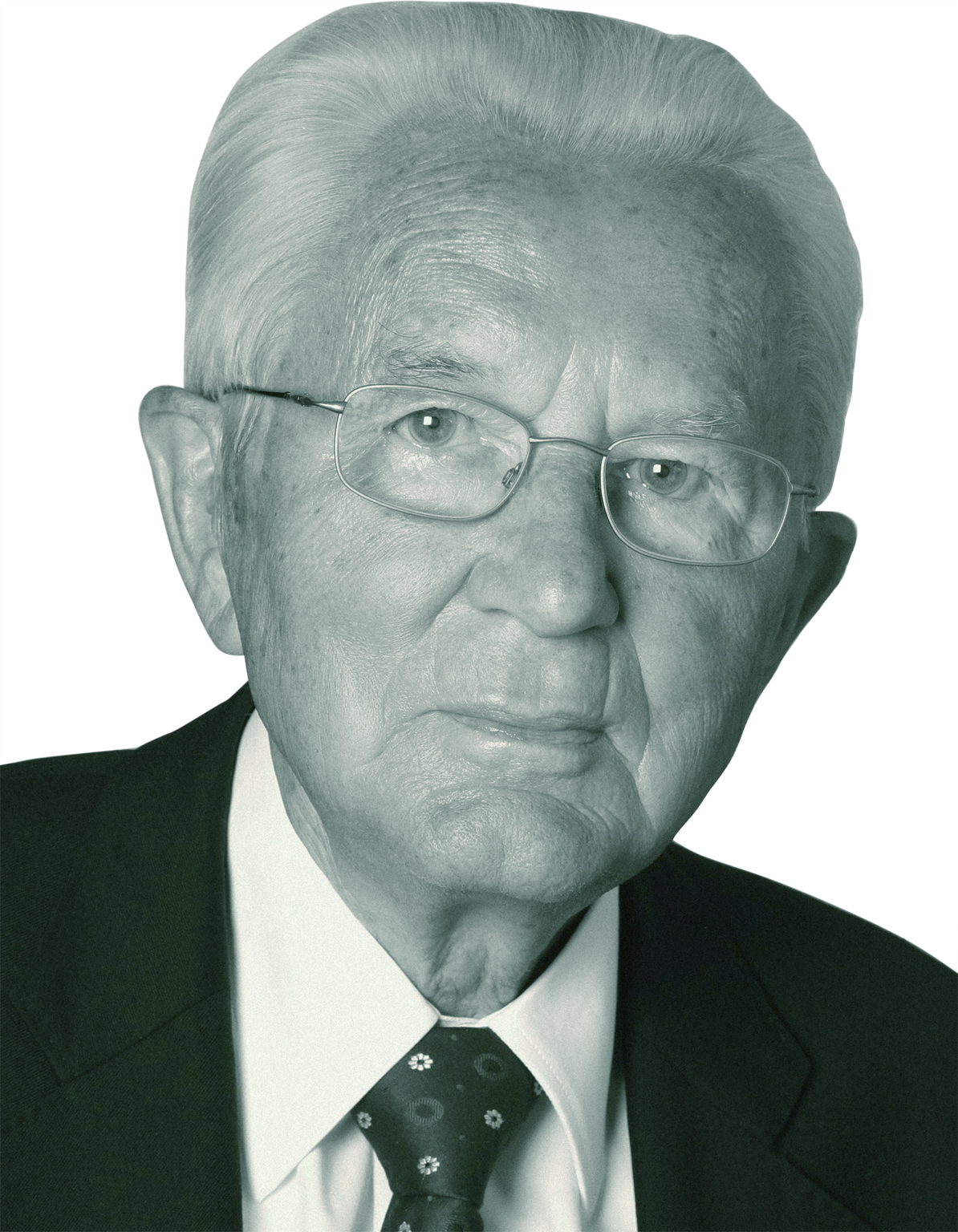
INGVAR KAMPRAD
1926–2018
The founder of Swedish furniture business IKEA, Ingvar Kamprad had a talent for sales and marketing, and a mission to provide customers with well-designed, affordable products. Unassuming and frugal, his thrifty ethos inspired innovative, low-cost furniture with a minimalist aesthetic that transformed the world of homeware.
Ingvar Kamprad began his career as an entrepreneur when he was just five years old, selling matches and garden seeds to neighbors in the small Swedish village of Agunnaryd, Småland, where he lived. He bought a bicycle with the profits from his early endeavors, and by the age of 10, he had moved on to cycling door-to-door selling pencils and Christmas decorations that he had bought in bulk. At 17, Kamprad was given a small sum of money for finishing school by his father, who was especially proud of his son because he was dyslexic. Kamprad used the money to found IKEA, a name he came up with using his initials and those of his home: Ingvar Kamprad from Elmtaryd, Agunnaryd. At first, IKEA was a mail-order business that sold products such as pencils and postcards. Kamprad soon added furniture made by local farmers to his catalog, and sales boomed.
“I see my task as serving the majority of people.”
Ingvar Kamprad, 2000
Flat-pack furniture
In the 1950s, Sweden underwent a period of rapid modernization that resulted in people moving from rural to urban areas. Many new apartments were built to provide accommodations in towns and cities. People wanted furniture that was easy to transport and carry up flights of stairs, and Kamprad provided this with a timely innovation. He saw the potential of flat-pack furniture when an employee tried to take a table to a catalog photo shoot by car. Kamprad realized he could sell flat-pack items at more affordable prices because they would be cheaper to manufacture, store, and move; savings would also be made on assembly costs. This simple concept of efficiency and economy became the driving philosophy behind IKEA and gave the company a significant competitive advantage over other furniture retailers.
At that time, IKEA was not the only mail-order business in Sweden. Among the many competitors were retailers that were squeezing prices and compromising on the quality of their products to gain a share of the market. To prove that IKEA was not just another poor-quality mail-order company, Kamprad offered potential buyers a chance to view his products in a showroom in the town of Almhult before they purchased them. As an added incentive to visit, browse, and buy, he also offered free coffee and buns. Opening in May 1953, the showroom was an instant hit with customers and also allowed Kamprad to collect valuable feedback on his furniture.

Kamprad had a light-bulb moment while watching an employee dismantle a table to fit it into a car. He realized that flat-pack furniture would be easier to transport and could be assembled at home.
“By always asking why we are doing this or that, we can find new paths.”
Ingvar Kamprad, 1976
KARL ALBRECHT

Taking over his mother’s grocery business in Essen, Germany, Karl Albrecht grew it into the global supermarket chain Aldi.
Albrecht (1920–2014) and his brother, Theo, started running the family store after serving in World War II (1939–1945) and soon opened more outlets. They kept their premises small, with warehouse-style fittings, and sold mainly nonperishable goods that were quickly replaced if they did not sell. This allowed them to cap prices. Today, Aldi (short for Albrecht Discount) has more than 11,000 stores.
Cost and convenience

From the start, Kamprad’s business ethos (later outlined in his 1976 manifesto “The Testament of a Furniture Dealer,” written for IKEA employees) was to offer “well-designed, functional home-furnishing products at prices so low that as many people as possible will be able to afford them.” Low cost and convenience were key to IKEA’s success: customers could visit a showroom, choose a piece of furniture, transport it home, and assemble it themselves, all on the same day.
Kamprad also held the belief that “no good business is done on an empty stomach.” He moved on from serving coffee and buns to establishing restaurants in his showrooms that offered (among other things) Swedish meatballs, a ubiquitous and popular culinary feature of every future IKEA store.
Unfortunately, Kamprad’s low prices provoked the ire of his larger competitors in the Swedish furniture market. By the mid-1950s, they had banned him from the country’s furniture fairs, and the National Association of Furniture Dealers had put pressure on local manufacturers to stop supplying IKEA. To combat these issues, Kamprad moved production to Poland, where manufacturing costs were lower, and brought all furniture design in-house.
During the 1960s, Kamprad expanded IKEA, opening new outlets in Oslo and Copenhagen. His furniture quickly gained a reputation for its contemporary design and use of modern materials. In 1968, inexpensive particleboard became a common feature of IKEA products. The 1969 PRIVAT sofa, with its particleboard base, became especially popular. Like the sofa, other classic items, such as the POÄNG armchair, MASTHOLMEN coffee table, and EKTORP sofa used the names of Scandinavian places or words. This was a deliberate device initiated by Kamprad, who found them easier to remember than numbers because of his dyslexia.
The IKEA empire continued to grow, but in 1994, Kamprad was again dogged by controversy. Stories appeared in the press about his wartime affiliation with the Swedish fascist group Nysvenska Rörelsen and its leader Per Engdahl. Kamprad apologized for these links in a letter to IKEA employees but remained friends with Engdahl. He also developed an alcohol problem that lasted until 2004.
By 2000, IKEA had more than 50,000 employees and 155 stores in 30 countries. Kamprad reduced his responsibilities, giving each of his sons—Peter, Jonas, and Matthias—part of the IKEA empire to run. In 2013, aged 87, Kamprad finally stepped down as chairman of the board, and Matthias took over his role.

Kamprad issued his first IKEA catalog in 1951; it became the company’s main marketing tool.
Thrifty billionaire
In 2004, Kamprad was reported to be one of the richest people in the world, although his personal fortune was the subject of conjecture. His full earnings were unknown because he ran IKEA through three holding entities: Inter IKEA Group, IKANO Group, and INGKA Group. Forbes magazine estimated that between 2005 and 2010, Kamprad had a net worth of around $28 billion (£22 billion).
Yet Kamprad was a billionaire who had little interest in the trappings of wealth. He chose to fly economy class, caught trains and subways instead of taking taxis, he trawled flea markets for clothes, and sought out cheap haircuts. He was famously refused entry to a gala dinner because the security guards had seen him arrive at the venue by bus.
Kamprad extended this democratic attitude to his company’s staff, who were referred to as “coworkers,“ wore informal uniforms, and were regarded as extended family. Commenting on his frugality, Kamprad stated: “If I start to acquire luxurious things then this will only incite others to follow suit. It’s important that leaders set an example. I look at the money I’m about to spend on myself and ask if IKEA’s customers could afford it.” Kamprad died in 2018, at the age of 91.
“I don’t fly first class on the airplanes, and the stores’ executives don’t either.”
Ingvar Kamprad, 1997
MILESTONES
FIRST CATALOG
Produces the first annual IKEA catalog in 1951, distributing it across Sweden.
SETS UP STORE
Opens a flagship store in Kungens Kurva, Stockholm, in 1965. After a fire in 1970, it reopens in 1971.
GOES GLOBAL
Launches IKEA stores in France, Belgium, the US, the UK, and Italy between 1981 and 1989.
TEACHES “IKEA”
Publishes A Little IKEA Dictionary in 1996. It contains words relating to the IKEA philosophy.
